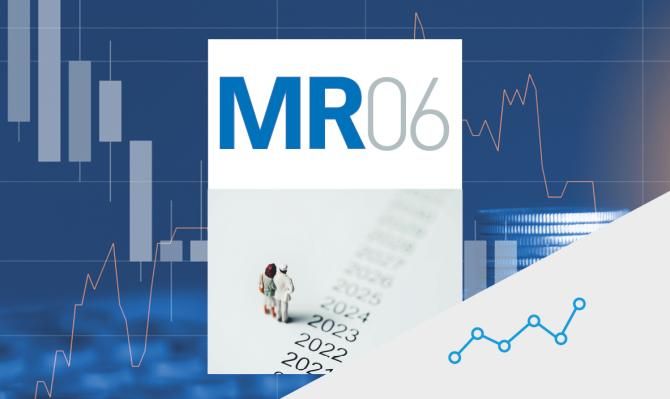The US debt ceiling and the landing of the economy determine investor sentiment
Following the instability involving the US regional banking system and Credit Suisse in March, and their gradual (and not always calm) digestion in April, in May investors’ attention shifted to other sources of uncertainty.

Following the instability involving the US regional banking system and Credit Suisse in March, and as investors gradually digested these changes in the environment in April (a process that was not without its incidents), in May investors’ attention shifted to other sources of uncertainty. Firstly, the negotiations around raising the US debt ceiling, which were unresolved up until the beginning of June, determined the investor mood in May, especially as the deadline approached. News about the progress of the negotiations either spurred on or stifled risk appetite in the markets and raised the yield on US Treasury bills in the shorter term, driving it up to a 20-year high of around 6%. Secondly, as concerns about financial instability receded, the health of the business cycle and the evolution of inflation regained prominence in the major developed economies.

After May kicked off with the Fed and the ECB raising benchmark interest rates by 25 as expected, as the month progressed and the doubts about financial stability faded, market expectations regarding interest rate levels in the coming months rose. For the Fed, after investors initially anticipated that May would bring the final rate hike of the current cycle, the strength of the labour market and the resilience of private consumption have now raised the possibility of additional 25-bp hikes in June or July. Nevertheless, a pause in the rate-hiking cycle at the June meeting remains the most likely scenario. In the euro area, with inflation figures still high (despite the stronger signs of moderation in May), coupled with statements by most members of the ECB’s Governing Council – including its president Christine Lagarde – stressing that the institution still has some way to go in this cycle, investors continue to expect that the reference rate will reach 3.75%.

The tensions over the debt ceiling, as well as Fitch’s revision of its US rating watch (despite maintaining its AAA rating, the agency revised the outlook from «stable» to «negative») and the release of the economic data for April, caused a gradual and widespread rebound in sovereign debt yields in the short-term sections of the yield curves during the first few weeks of May, exacerbating their inversion. However, after progress was made in the political negotiations in the closing days of the month, these rallies were reversed both in the US and, even more sharply, in the euro area. Here, the slowdown in inflation in May, coupled with the continued signs of weakness in the industrial sector according to the business surveys, led 2-year benchmark rates to end the month almost flat. In the United Kingdom, in contrast, the worrying core inflation data drove 2-year debt yields to climb above 4.5%.

In May, the depreciation experienced by the dollar since the beginning of March was reversed. This depreciation had initially been triggered by the financial instability in the US regional banks, which had lowered expectations for benchmark interest rates much more sharply for the Fed than for the ECB, thereby favouring the euro. However, the role of the dollar as a safe-haven currency amid the uncertainty surrounding the debt ceiling, as well as the gradual rise in expectations for rate hikes in the US, favoured the appreciation of the US currency relative to its major peers. Thus, after exceeding the level of 1.10 per euro, the dollar appreciated by 3%, to below 1.07 per euro. The dollar also appreciated against the yen (2.2%), although it depreciated against the pound sterling (1%) as the inflation data in the United Kingdom could pressure the Bank of England to implement further rate hikes.

May was the month with the weakest stock market performance so far this year in Europe, both in the Euro Stoxx 50 (–3.2%) and on the main national trading floors, with Portugal’s PSI-20 performing particularly poorly (–7.8%). This pattern is explained both by the poorer performance of banking stocks and by the declines in the luxury sector (which affect the Italian and French indices in particular), weighed down by a reopening of the Chinese economy which has fallen short of expectations. This has also weighed on Hong Kong’s Hang Seng index, which was down more than 8% in the month and fell to its lowest level this year. In the US, the tech sector performed particularly well (Nasdaq +7.5% in the month) compared to the rest (S&P flat with +0.2%). Also of note was the performance of US regional banking stocks: although the KBW index fell 6% in the month, the rapid deterioration observed in March and April appears to have ended, with several banks showing a stabilisation in their deposits in their earnings presentations.

Energy prices registered their biggest declines of the year in May, with a cumulative decrease of almost 25% in the past five months. In the oil market, the Brent barrel ended the month below 73 dollars, dragged down by China’s slower economic recovery and despite the intention of some OPEC countries to maintain their current production cuts. On the other hand, in Europe tensions relating to the gas market continued to ease. In addition to the continuous flow of liquefied natural gas supplies from the US and Qatar, energy generation from renewables registered a record high and there was a slowdown in the demand for gas across the continent, having reduced by almost 20% in the first four months of the year compared to the previous year. These factors, combined with the mild temperatures, favoured the acceleration of the filling of gas reserves (which are already back at almost 70% of capacity) as well as a drop in gas prices down to the levels of two years ago (around €25/MWh in the case of the TTF).
